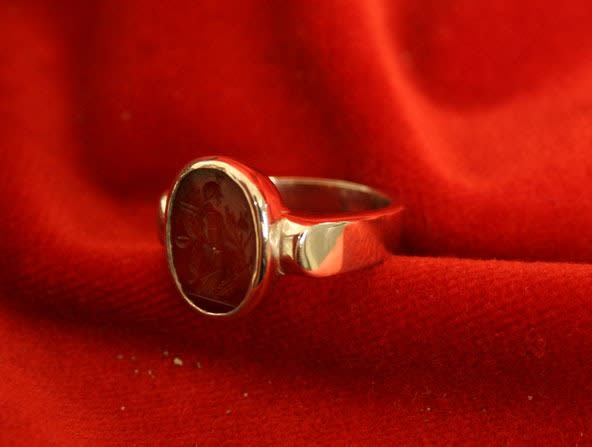Roman Carnelian Intaglio Depicting Fortuna, 100 CE - 300 CE
Carnelian-Gold
FJ.6818
Further images
This Genuine Ancient Seal Has Been Set in a Modern 18 Karat White Gold Rin The art of glyptics, or carving on colored precious stones, is probably one of the...
This Genuine Ancient Seal Has Been Set in a Modern 18 Karat White Gold Rin
The art of glyptics, or carving on colored precious stones, is probably one of the oldest known to humanity. Intaglios, gems with an incised design, were made as early as the fourth and third millennia B.C. in Mesopotamia and the Aegean Islands. They exhibit a virtuosity of execution that suggests an old and stable tradition rooted in the earliest centuries. The tools required for carving gems were simple: a wheel with a belt-drive and a set of drills. Abrasives were necessary since the minerals used were too hard for a metal edge. A special difficulty of engraving intaglios, aside from their miniature size, was that the master had to work with a mirror-image in mind.
The goddess of chance, Fortuna, stands wearing an elegant dress on this ancient Roman intaglio. She holds her most notable attribute: the cornucopia. This suitable emblem suggests the bounty that chance is able to bestow upon the fortunate few. This intaglio demonstrates the absolute mastery of Roman glyptic craftsmen. The level of detail and clarity is stunning considering the limited proportions of the polished surface of the gemstone and the difficulty carving such a dense, hard material. Today set in a marvelous 18 Karat white gold ring, this gorgeous piece of jewelry invokes the glories of Ancient Rome. Wearing this ring reveals a love for the past and for the timeless beauty of the Classics. Surely, the goddess Fortuna has favored anyone so lucky to wear this stunning ring.
The art of glyptics, or carving on colored precious stones, is probably one of the oldest known to humanity. Intaglios, gems with an incised design, were made as early as the fourth and third millennia B.C. in Mesopotamia and the Aegean Islands. They exhibit a virtuosity of execution that suggests an old and stable tradition rooted in the earliest centuries. The tools required for carving gems were simple: a wheel with a belt-drive and a set of drills. Abrasives were necessary since the minerals used were too hard for a metal edge. A special difficulty of engraving intaglios, aside from their miniature size, was that the master had to work with a mirror-image in mind.
The goddess of chance, Fortuna, stands wearing an elegant dress on this ancient Roman intaglio. She holds her most notable attribute: the cornucopia. This suitable emblem suggests the bounty that chance is able to bestow upon the fortunate few. This intaglio demonstrates the absolute mastery of Roman glyptic craftsmen. The level of detail and clarity is stunning considering the limited proportions of the polished surface of the gemstone and the difficulty carving such a dense, hard material. Today set in a marvelous 18 Karat white gold ring, this gorgeous piece of jewelry invokes the glories of Ancient Rome. Wearing this ring reveals a love for the past and for the timeless beauty of the Classics. Surely, the goddess Fortuna has favored anyone so lucky to wear this stunning ring.







